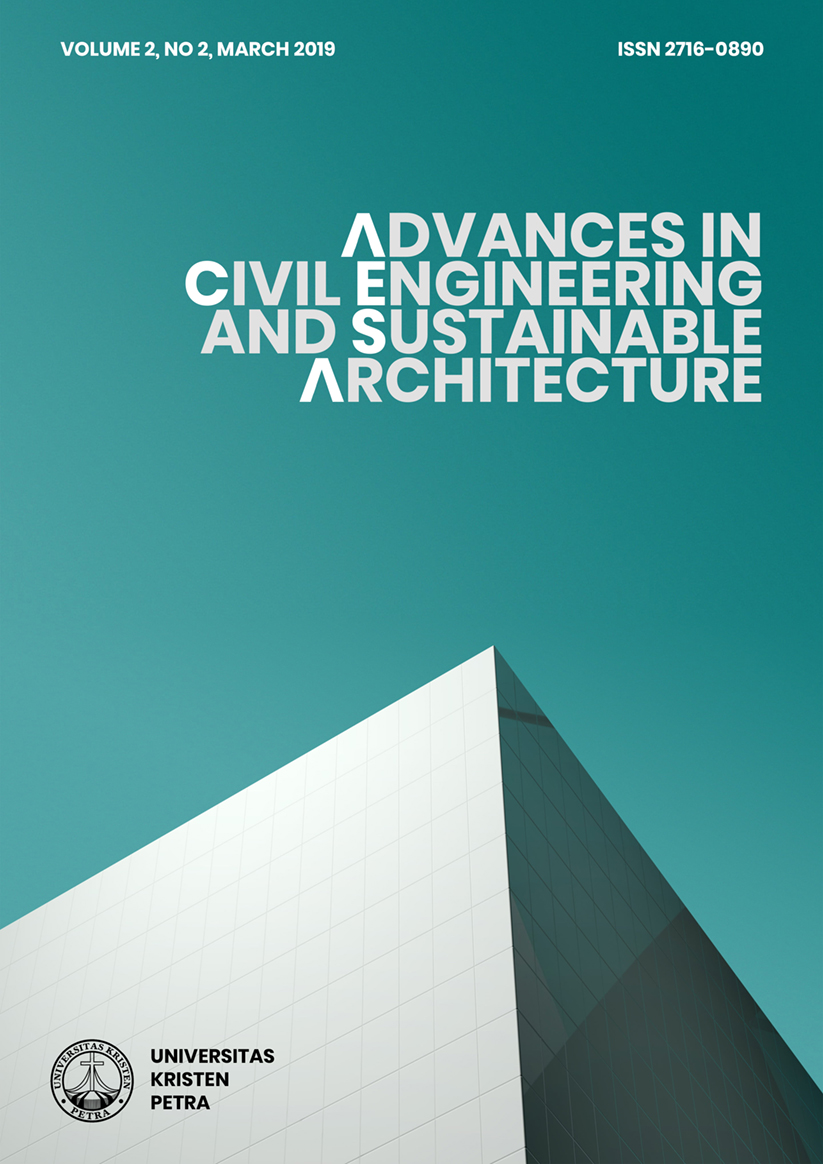MICROALGAE AS A SUSTAINABLE FACADE FOR OCCUPANTS’ HEALTH: A REVIEW
DOI:
https://doi.org/10.9744/acesa.v4i1.11901Abstract
Facade as a sustainable strategy can provide energy-efficient solutions. Some designers' knowledge of the sustainable paradigm is incomplete, resulting in façade components that are harmful to occupants' health. The development of facade microalgae can be a sustainable facade solution. The purpose of this study is to examine the microalgae façade with the parameters of Strategies for Sustainable Architecture: Health by Paola Sassi through an analysis of the space comfort and the materials used. The research method is qualitative with a descriptive type of research from previous research articles and journals that discuss the microalgae facade. The results showed that the microalgae facade provides optimal quality of space comfort with materials that decrease pollution. According to the findings, microalgae facades as a sustainable strategy for occupant health and the environment. The microalgae facade as green technology is not only for building performance but also for the health of building occupants.
References
1. BMKG. (2021). Ekstrem Perubahan Iklim | BMKG. BMKG | Badan Meteorologi, Klimatologi, dan Geofisika. https://www.bmkg.go.id/iklim/?p=ekstrem-perubahan-iklim&lang=ID
2. Bonenberg, W., & Kapliński, O. (2018). The architect and the paradigms of sustainable development: A Review of dilemmas. Sustainability, 10(1), 15. https://doi.org/10.3390/su10010100
3. Brasington, L. (2019, June). Heating, ventilation and air conditioning (HVAC) systems, the next building load to optimize | Cleantech Group. https://www.cleantech.com/heating-ventilation-and-air-conditioning-hvac-systems-the-next-building-load-to-optimize/
4. Casini, M. (2016). Energy-generating glazing. In Smart Buildings (pp. 327–353). Elsevier. https://doi.org/10.1016/B978-0-08-100635-1.00010-1
5. Chel, A., & Kaushik, G. (2018). Renewable energy technologies for sustainable development of energy efficient building. Alexandria Engineering Journal, 57(2), 655–669. https://doi.org/10.1016/j.aej.2017.02.027
6. Elnokaly, A., & Keeling, I. (2016). An empirical study investigating the impact of micro-algal technologies and their application within intelligent building fabrics. Procedia - Social and Behavioral Sciences, 216, 712–723. https://doi.org/10.1016/j.sbspro.2015.12.067
7. Fytrou-Moschopoulou, A. (2015, April 29). The BIQ House: First algae-powered building in the world [Text]. Build Up. https://www.buildup.eu/en/practices/cases/biq-house-first-algae-powered-building-world
8. Genin, S. N., Aitchison, J. S., & Allen, D. G. (2016). Photobioreactor-Based Energy Sources. In F. Pacheco Torgal, C. Buratti, S. Kalaiselvam, C.-G. Granqvist, & V. Ivanov (Eds.), Nano and Biotech Based Materials for Energy Building Efficiency (pp. 429–455). Springer International Publishing. https://doi.org/10.1007/978-3-319-27505-5_16
9. GmbH, C. (2019, June). How a bioenergy facade works. Cellparc. https://cellparc.com/en/function/
10. Haase, M., Marques da Silva, F., & Amato, A. (2009). Simulation of ventilated facades in hot and humid climates. Energy and Buildings, 41(4), 361–373. https://doi.org/10.1016/j.enbuild.2008.11.008
11. Haghir, S., Tashakori, L., Rezazadeh, H., & Ahmadi, F. (2020). Algae facade for reducing CO2 emission and mitigating global warming (Case study: Tehran Enghelab Street). Bagh-E Nazar, 17(89), 37–48. https://doi.org/10.22034/bagh.2020.188585.4147
12. Kim, K.-H. (2014). A feasibility study of an algae façade system. International Conference on Sustainable Building Asia, 333–341.
13. Malik, A., Lan, J., & Lenzen, M. (2016). Trends in global greenhouse gas emissions from 1990 to 2010. Environmental Science & Technology, 50(9), 4722–4730. https://doi.org/10.1021/acs.est.5b06162
14. McKenna, S. T., Jones, N., Peck, G., Dickens, K., Pawelec, W., Oradei, S., Harris, S., Stec, A. A., & Hull, T. R. (2019). Fire behaviour of modern façade materials – Understanding the Grenfell Tower fire. Journal of Hazardous Materials, 368, 115–123. https://doi.org/10.1016/j.jhazmat.2018.12.077
15. Miceli, M. (2013, April 24). Worlds first microalgae facade goes live—Arup. https://www.arup.com/news-and-events/worlds-first-microalgae-facade-goes-live
16. Pagliolico, S. L., Verso, V. R. M. L., Bosco, F., Mollea, C., & La Forgia, C. (2017). A novel photo-bioreactor application for microalgae production as a shading system in buildings. Energy Procedia, 111, 151–160. https://doi.org/10.1016/j.egypro.2017.03.017
17. Richmond, A. (2004). Principles for attaining maximal microalgal productivity in photobioreactors: An overview. Hydrobiologia, 512(1–3), 33–37. https://doi.org/10.1023/B:HYDR.0000020365.06145.36
18. S, A., Arianti, R. F., Pradana, Y. S., Suyono, E. A., Koerniawan, M. D., Suwanti, L. T., Siregar, U. J., & Budiman, A. (2020). The design of microalgae (Chlorella sp.) photobioreactor as a façade bus shelter building in Indonesia. AIP Conference Proceedings, 2296(1), 1–9.
19. Sassi, P. (2006). Strategies for sustainable architecture. Taylor & Francis.
20. Soltani, S. (2016). The Contributions of Building Information Modelling to Sustainable Construction. World Journal of Engineering and Technology, 04(02), 193–199. https://doi.org/10.4236/wjet.2016.42018
21. Studio, U. (2021). Algae Tower. https://uooustudio.com/algae-tower
22. Susanto, Y. R. (2012). Optimasi pencahayaan alami dan buatan pada gedung Universitas Kristen Petra (P1 dan P2). Petra Christian University.
23. Talaei, M., Mahdavinejad, M., & Azari, R. (2020). Thermal and energy performance of algae bioreactive façades: A review. Journal of Building Engineering, 28, 101011–101025. https://doi.org/10.1016/j.jobe.2019.101011
24. Wolkers, H., Barbosa, M., Kleinegris, D., Bosma, R., & Wijffels, R. H. (2011). Microalgae: The green gold of the future? 32.
25. Zagi, N. Z. (2017). Studi penerapan solarleaf – The bioreactor facade sebagai solusi alternatif arsitektur tanggap iklim dan energi. Jurnal Lingkungan Binaan Indonesia, 6(1), 65–69. https://doi.org/10.32315/jlbi.6.1.64
Downloads
Published
Issue
Section
License
Authors who publish with this journal agree to the following terms:
Authors retain copyright and full publishing rights without restrictions, with the work simultaneously licensed under the terms and conditions of the Creative Commons Attribution License (CC BY) that allows for unlimited use, distribution, and content reproduction on all media as long as the original author and source are properly acknowledged and cited.











